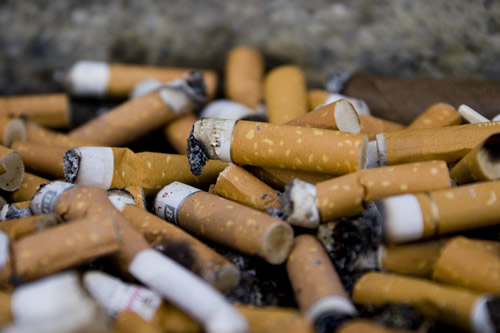Discarded cigarettes butt, waste disposal and environmental pollution hazard
 Chemists at the University of Nottingham have discovered that cigarette butt-derived carbons have ultra-high surface area and unprecedented hydrogen storage capacity likely to cause pollution.
Chemists at the University of Nottingham have discovered that cigarette butt-derived carbons have ultra-high surface area and unprecedented hydrogen storage capacity likely to cause pollution.
Discarded cigarette butts were otherwise a major waste disposal and environmental pollution hazard.
The research superintended by Robert Mokaya, Professor of Materials Chemistry, and Troy Scott Blankenship, an undergraduate project student, in the School of Chemistry and has been published in the academic journal Energy and Environmental Science, a copy of which was made available to the Ghana News Agency.
Professor Mokaya said: “We have utilised cigarette butt waste as starting material to prepare energy materials that offer unprecedented hydrogen storage properties. This may not only address an intractable environmental pollution problem — cigarette butts — but also offers new insights into converting a major waste product into very attractive hydrogen storage materials.”
Hydrogen is attractive as a fuel because whether it is burned to produce heat or reacted with air in a fuel cell to produce electricity, the only by-product is water.
Solving a major waste disposal problem
Every year nearly six trillion cigarettes are smoked worldwide. This generates more than 800,000 metric tons of cigarette butts. Apart from causing unsightly litter, cigarette butts contain contaminants such as toxic heavy metals which can leach into waterways potentially causing harm to both humans and wildlife.
Cigarette butts — used cigarette filters — are a lingering pollution hazard because they mainly contain cellulose acetate which is non-biodegradable. However, the cellulose acetate makes them an attractive starting material for valorisation to porous carbons. Such valorization is in line with the current trend to move away from coal-based carbonaceous precursors to biomass-derived or waste-based starting materials for porous carbon synthesis.
Turning waste into fuels or energy sources
Hydrothermal carbonisation, a process that requires only water and heat, of discarded cigarette butts yields a carbon product called hydrochar. The research team found that when the hydrochar is activated it generates oxygen rich porous carbons that have very high surface area.
Professor Mokaya said: “We show that activated carbons derived from cigarette butts or filters, via sequential benign hydrothermal carbonisation and activation, are super porous with ultra-high surface area and exhibit unprecedentedly high hydrogen storage capacity.”
“This work not only raises the interesting question of whether valorisation can solve the intractable cigarette butt problem but also offers porous carbons that attain new levels of hydrogen storage for porous materials in general.”
As part of the drive towards the ‘Hydrogen Economy’, in which hydrogen is used as a low-carbon energy source, this technique could be developed to replace, for example, gasoline as a transport fuel or natural gas as a heating fuel.
This publication is part of the team’s ongoing search for sustainable carbons with optimized properties as energy materials including for hydrogen storage.
Source: GNA
